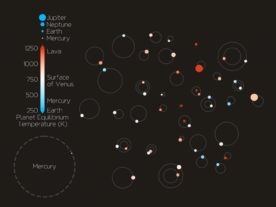The search for the mysterious sub-atomic particle known as the Higgs boson may soon be over.
Two teams at the U.S. Department of Energy’s Fermi National Accelerator Laboratory report they’ve seen hints of a Higgs boson and that the results of their experimentation are consistent with those conducted with the Large Hadron Collider (LHC).
A few months ago, two independent teams of scientists, working with the LHC at CERN, announced they have a good idea where the Higgs boson might be found and that a discovery could happen sometime in 2012.
The two teams from the U.S. Department of Energy made their findings by examining extensive data from Fermi’s Tevatron accelerator, which has since been shut down.
“The end game is approaching in the hunt for the Higgs boson,” said Jim Siegrist, DOE associate director of Science for High Energy Physics. “This is an important milestone for the Tevatron experiments, and demonstrates the continuing importance of independent measurements in the quest to understand the building blocks of nature.”
Stay tuned – will we soon have an exciting conclusion in the quest for the Higgs boson?
When it comes to social media, a picture is worth 1,000 words
If you post the right profile photo at your favorite social media site, the accompanying text really doesn’t matter, according to a new study from the US mid-west state of Ohio.
Researchers have found your profile photo already tells visitors all they need to know to form an impression of you.
In other words, a picture is indeed worth a thousand words.
A group of college students was shown four phony Facebook profiles. Each included a photo and written autobiographical sketch.
One of the profiles showed a photo of someone socializing with friends along with the text – “I’m happiest hanging out with a big group of friends.”
Another profile had a picture of a person sitting alone on a park bench with the text, “I’m happiest curled up in my room with a good book.” The two other profiles mixed the photo impression with the text statement.
The researchers wanted to discover whether the photo or the text helped the viewer decide whether the person was an extrovert or an introvert. And the results showed that the photo was indeed most important.
If a person was perceived to an extrovert in the profile picture, the test subjects assumed that they were, despite what the accompanying text communicated.
The study is headed by Brandon Van Der Heide, an assistant professor of communication at Ohio State University, who says, “Photos seem to be the primary way we make impressions of people on social networking sites.”
California lab working on new radiation contamination treatment

A baby born four days after the 2011 Fukushima earthquake and tsunami, is tested for possible nuclear radiation at a local evacuation center. (REUTERS/Kim Kyung-Hoon)
As we close in on the one-year anniversary of the Japan earthquake, which triggered a tsunami and resulting nuclear crisis, the U.S. Department of Energy has announced its scientists are working on a new, more effective radiation decontamination treatment, which can be quickly administered in the form of a pill.
Last year, with the reactors at the Fukushima Daiichi nuclear power plant nearing meltdown stage and rates of radiation rapidly increasing, Japanese officials needed to quickly develop ways to treat possibly thousands of people for nuclear radiation contamination. But their solutions were limited.
Current treatment methods are considered outdated and limited in scope. The only chemical agent now available for decontamination is a compound known as DTPA, which must be administered intravenously and, even then, only partially removes some of the deadly radioactive chemical elements which pose the greatest health threats to people.
Officials at the Department of Energy’s Lawrence Berkeley Lab in California, say the new pills being developed would excrete about 90 percent of the most serious deadly radiation contaminants within 24 hours.
Taking one pill daily for two weeks should be enough to remove virtually all of those contaminants from a person’s system.
Chimpanzees police officers keep the peace
It turns out that humans aren’t the only living creatures who turn to law enforcement to help maintain peace and order.
A new study reveals that our evolutionary cousin, the chimpanzee, also takes advantage of an uninvolved third party to keep the peace and help mediate conflicts.
The study’s authors say this behavior can be taken as an early evolutionary form of morality.
Study leaders, Carel van Schaik and Claudia Rudolf von Rohrthe, both anthropologists from the University of Zurich, say their research confirms chimpanzees impartially intervene in resolve conflicts in order to guarantee peace and stability within their communities.
Van Schaik and von Rohrthe say this activity and involvement exhibits pro-social behavior based on an interest in community concern.
The researchers found that this policing activity was rare and is usually done by high-ranking members of a chimpanzee group or community.
They also found that these arbiters appeared to be more willing to impartially get involved with mediating a conflict if the dispute involved several quarrelers, probably because such conflicts are more likely to jeopardize group peace.
“The interest in community concern that is highly developed in us humans and forms the basis for our moral behavior is deeply rooted. It can also be observed in our closest relatives,” says von Rohr.
























The problem with particle events in accelerators is that first we mostly postulate them theoretically then want to see them buried in a lot of noise. Just spotting a few of them makes us believe that our whole theory is right. However, it may not be so; they just could be freak fragments, like the ones we get after an earthquake, the fragments are not exactly what went into building those structures. Higgs boson also is part of that slightly deluding scientific approach.
Gravity has roots in some very apparent physics. laugh it off, as it’s not easy to realize that basic quantum leap itself is a source of gravitation.